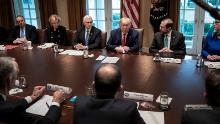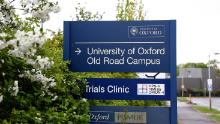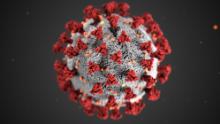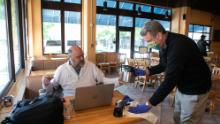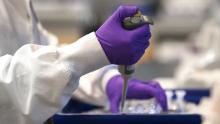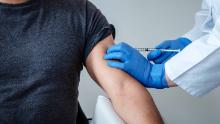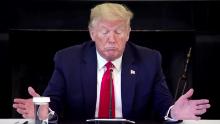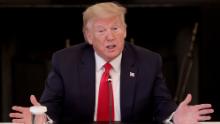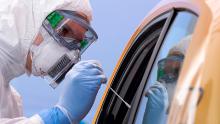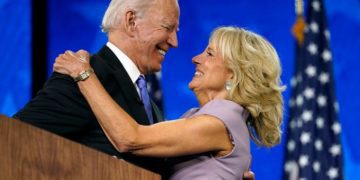[ad_1]
One by one, vaccine developers at a White House roundtable convened by President Donald Trump in early March pitched their product as a viable solution to the coronavirus that was spreading globally and killing Americans.
John Shiver, the head of R&D for Sanofi Pasteur vaccines, said he could have a product ready for the clinic in a year — perhaps a vaccine for the public in as “few as several years.”
Trump seemed uninterested.
Next was Lenny Schleifer, the founder and CEO of Regeneron — which aims to conduct clinical trials this summer — who talked of pumping 200,000 doses per month of its therapeutic vaccine from his factory, starting in August, “if all goes well.”
This got Trump’s attention. He leaned over the table and interrupted Schleifer mid-pitch.
“So that process would be faster than John’s?” he said, pointing at Shiver.
“It would be,” Schleifer said, adding that the process could take “weeks to months.”
The only way to top that was to start talking about days, and it’s exactly what the next CEO did.
Stéphane Bancel of Moderna Inc. glanced across the table at the nation’s top infectious disease expert, Dr. Anthony Fauci, and said he is “very proud to be working with the US government and to have already sent, in only 42 days from the sequence of the virus, our vaccine to Dr. Fauci’s team at the NIH.”
The French-born Bancel went on to say that he needed just “a few months” to start phase two of a three-part clinical trial of the sort that typifies vaccine development. (The entire process often takes more than a decade.)
Trump seemed to tune out everything but the talk of time.
“So you’re talking over the next few months, you think you could have a vaccine?” he asked.
“Correct. Correct,” Bancel said, raising a hand to acknowledge Fauci shifting in his chair across the table. “With phase two,” Bancel clarified, just before Fauci interjected, for Trump’s benefit: “You won’t have a vaccine. You’ll have a vaccine to go into testing.”
To some observers, it was a classic Bancel performance — a rare public glimpse into his uncanny ability to say the right thing to the right people in the right moment.
His supporters say, however, he was doing what he’s always done: letting Moderna’s accomplishments speak for themselves.
Either way, it turns out Moderna had an edge. Its scientists had already been collaborating with researchers from the National Institutes of Health on a vaccine for another coronavirus, Middle Eastern Respiratory Syndrome (MERS). So when Chinese researchers released the genomic sequence for the new coronavirus — SARS-CoV-2, which causes the deadly disease known as Covid-19 — in mid-January, they had a jump start.
Established in 2010, Moderna has never brought a product to market, or gotten any of its nine or so vaccine candidates approved for use by the FDA. It has also never brought a product to the third and final phase of a clinical trial.
And yet at the moment, it represents one of the country’s — and possibly world’s — best hopes for a return to the normalcy that slipped away when the microscopic enemy brought civilization to a standstill.
Major funding injected into vaccine race
The effort received another boost on April 16, when the federal Biomedical Advanced Research and Development Authority (BARDA) awarded Moderna up to $483 million to accelerate the development and manufacturing of the vaccine. That amounts to about half of what the federal agency has doled out, with Janssen Research & Development — part of Johnson & Johnson — receiving $456 million, and a third company, Sanofi, receiving up to $30 million.
As it happens, although Moderna is not a household name, it’s a company with a storied history.
CNN Investigates interviewed more than 20 experts and former employees for this story and found that while some of the scientists expressed optimism that Moderna can pull it off, others voiced criticism about the hype the company has generated over the years, as well as what has been described as a caustic work culture.
Others raised concerns about the science, or challenged the wisdom of the federal government-sanctioned shortcuts in the ongoing clinical trial, in particular the FDA’s approval to gloss over the animal trials that normally precede injecting an untested vaccine into healthy humans.
Dr. Joseph Bolen, who served as Moderna’s chief scientific officer and president of research and development from 2013 to 2015, believes it was reasonable to give Moderna a shot, but was puzzled by BARDA’s massive allocation — up to $483 million — calling it a “big bet.”
“I don’t know what their thinking was,” he said. “Why so much? … I just don’t know. When I read that, I was pretty amazed.”
Dr. Tal Zaks, Moderna’s chief medical officer, acknowledged that the company doesn’t have a product on the market, but said the government’s decision was wise.
“We’re a young company with an emerging technology and for that reason we have not yet brought anything to full licensure,” he told CNN. “But if you look at the building blocks of what we have been able to demonstrate over time — from preclinical through our early clinical data — this is a very promising technology.”
Moderna is ahead of the pack
Moderna, Inc. — originally called Moderna Therapeutics — was founded on a big idea that would disrupt the pharmaceutical industry.
Its vision is to harness a new technology that synthesizes messenger RNA, or mRNA — essentially an instruction manual in every living cell for creating protein — to prompt the human body to make its own medicine. The hope has been to find “transformative” treatments for heart disease, metabolic and genetic diseases, kidney failure, even cancer.
BARDA said it plans to fund a variety of approaches.
“More than one vaccine is likely to be the solution,” a BARDA spokesperson said in an email. “Of note, Moderna was the first into the clinic with a vaccine.”
Over the years, Moderna has sold investors on the revolutionary potential of its medicine. Bancel has been the chief narrator of the company’s intoxicating story.
Ambition, secrecy and money has earned Moderna critics
But Moderna’s unbridled ambition, reputation for secrecy and preoccupation with venture capital have earned it detractors.
“Deals don’t validate science,” the op-ed said. “Biotech is littered with examples of big money acquisitions or licenses written off or abandoned subsequently.”
“They’ve been a little tight-fisted about their data,” said a former BARDA official who now works as a biotech expert at Biologics Consulting and has worked with Moderna. “And I interpret that to mean the results so far have been disappointing.”
In a rare interview, Noubar Afeyan, one of Moderna’s four co-founders and the current board chairman, told CNN the company’s reputation for secrecy is misunderstood.
“They mistake secrecy for ambiguity,” he said of critics, noting that the company didn’t publish in the early days because it had nothing to publish — it was in the experimental phase.
But Matthias John, a molecular biologist who was a group leader and senior research fellow at Moderna for nearly four years ending in 2016, remembers being told not to publish even when he had good data.
“They had really this fear to disclose results,” he said, adding that the company worried it would allow competitors to catch up to their innovations. “It was just a pity. … We had fantastic data back then.”
Critics call for more skepticism
One former employee, who worked at the company for three years ending in 2019 — most recently as a director — called the comparison “absurd.”
“I think Moderna has a strong compliance culture,” said the former director, who spoke on condition of anonymity, saying the biotech industry is a small world and he didn’t feel comfortable making a public statement. “They are very driven. They have a strong vision, they work really hard.”
But a former company executive had a more mixed take on the question. On the one hand, he said, the science is on a “good foundation.”
“They really are pushing forward the boundaries of understanding RNA,” said the former executive, who requested anonymity because he still works in the field.
In his view, though, Moderna is a company that “believes their own story, spins their own story and has managed to convince a lot of investors — in-biotech investors and other non-biotech investors — that it’s true,” he said. “I think (people) should approach it with a little more skepticism.”
Moderna’s turbulent start
In the early years, Moderna was a chaotic place. Over the span of a decade, the size of its workforce has expanded from four employees to more than 700.
But there were growing pains, some of which centered on Bancel, the only CEO the company has ever had.
Afeyan, a venture capitalist with a PhD in biochemical engineering from MIT, had tried to recruit Bancel to lead other projects, but Bancel — formerly the CEO of a French diagnostics company — had turned him down.
When Afeyan asked him to join Moderna, the idea was too big for Bancel to resist. The holder of a Master of Science in chemical engineering from the University of Minnesota and an MBA from Harvard Business School joined in 2011.
The former executive, who left in 2016, recalled that Bancel seemed to have two versions of himself: the calm public persona who makes speeches and appears on TED Talks, and the private version in corporate meetings.
“What you hear in corporate meetings is stuff like this, ‘What the f**k are you taking about? It’s complete bullsh*t. … You just said six-to-nine months; I need it done in five.'”
Dr. Suhaib Siddiqi, a chemist who served for a short time as Moderna’s former director of chemistry in 2011, said Bancel was “unfriendly” and “arrogant,” and punished technicians for failed experiments.
“Ninety percent of the things in science fail — that’s the way the inventions are made,” Siddiqi said. “When it failed (at Moderna), he just shifted the blame to the technicians and fired them.”
Bancel disputes the characterization.
“Science is complicated and many things fail,” Bancel, who declined CNN an interview, responded in a written statement. “I don’t recall one employee being fired since we started the company, because of science failing. If that had been the case, most scientists would have left the company and the company could not have gotten to the point it is.”
He added: “We are creating a new class of transformative mRNA medicines to improve the lives of patients. When there is an opportunity to help patients, every day matters. So, there is an urgency to what we are doing because patients are waiting. We are privileged to be a part of a broad ecosystem of researchers from academia and industry who are expanding the understanding of mRNA.”
Some former employees spoke in defense of Bancel.
“As a person I like him,” said Matthias John, the molecular biologist that left in 2016. “He’s a little bit of a fanatic. But he’s not in my opinion a cheater or pretender. It is his personality — that he’s pushing hard and he expected everybody’s pushing the same way.”
The former director who left in 2019 said Bancel has brought in a leadership team with experience in biopharmaceutical development that has “tempered the intensity.”
Rossi said he butted heads with Bancel, and that the company and its investors had a way of taking credit for the ideas of its scientists, including his own — an allegation that Moderna’s leadership denies.
But Rossi, who later went on to become an associate professor at Harvard Medical School and is now the CEO of another biotech company called Convelo Therapeutics, said he believes in the technology. He continues to have a financial stake in the company.
“I’m very optimistic,” he said. “It’s still going on the exact concept that it was founded on.”
Rossi, who said that he’s heard that the culture at Moderna has mellowed, added that on some level, the cutthroat nature of the place made sense.
“I founded the company because I wanted to make an impact on human health,” he said. “The CEO’s job is to make money for investors.”
Afeyan, the Moderna board chairman, fiercely defends Bancel. He told CNN the characterizations of Bancel as a gifted fundraiser are misplaced and even “derogatory,” saying it’s a way for detractors to smear him with faint praise.
“He’s a skilled team builder, he’s a skilled product developer, he’s a skilled strategist, he’s a skilled partnership forger … he’s all of those things,” Afeyan said. “In order to fuel all that, he needs to have come up with money and we did, in a way that’s unprecedented in the biotech industry. Also by tenfold. That’s why he has detractors.”
The big deals that shaped Moderna
Afeyan said it is true that Alexion’s experiments showed animal toxicity, but added that Moderna has since changed its formulations and, in human trials, “we haven’t seen any of that.”
Moderna gradually began to shift more focus on vaccines. Experts and former employees say that progress with therapeutics was much slower and more difficult to get to point where it could be used as promised in humans. Messenger RNA activates the body’s instinct to get rid of the foreign invader, which works better for single dose vaccines but creates safety issues for longer-term use in chronic diseases.
Jeff Ellsworth, who served as Moderna’s former senior director of preclinical pharmacology and the head of rare genetic diseases until he left in 2013, remembers standing around a white board in his office with two company executives, discussing the data used in animal studies for drugs meant to treat rare genetic diseases.
“We all kind of looked at each other and said, ‘Oh. We should probably be a vaccine company,’ because these things stimulate antibody responses,” he said.
Said Rossi: “It’s the perfect technology for the threat we face.”
“Most of the biotech community did not value vaccines,” Ellsworth said. “It was very hard to move that stuff forward. Because people said, ‘Oh, vaccines, nobody’s going to pay for that — it’s no big deal.'”
“In our lifetime?” Cramer asked.
“It’s happening actually right now,” Bancel answered. “We compare every letter of DNA … of a cancer cell and a healthy cell, and from that we deduce what do we need to do in our product, just for your cancer.”
“It’s almost science fiction, what you’re up to,” Cramer replied. “I think it’s incredible.”
Moderna’s valuation ballooned to $7.5 billion — up from an already impressive $5 billion from a year and a half prior.
Then came the new coronavirus and Covid-19, which has killed nearly 63,000 Americans since February and 233,000 people worldwide.
For the world, it was a disaster. For Moderna, it arrived just in time.
As the economy tanked, shares in Moderna surged in February when the news of its vaccine emerged. They shot up again — by more than 24 percent, to $26.49 — on March 16, the day the clinical trial of its vaccine made headlines. The stock price kept rising and rocketed again on April 17 — with news of the federal government’s nearly half-a-billion-dollar investment — to beyond $45. Its valuation climbed to $10 billion.
Vaccine pipeline is a funnel: ‘very few things survive’
To try to bring a vaccine to market is to try to beat the odds.
Dr. Myron Levine, a professor and infectious disease expert at the University of Maryland School of Medicine, cautioned that most vaccines fail.
“I’ve been in this business a very long time — a half a century,” he said. “A vaccine pipeline is the shape of a funnel. A lot of things go in one end; very few things survive.”
Still, Levine thinks Moderna could make a breakthrough.
“There’s a real good chance this will be the moment for the RNA vaccine — they’ve been improved and tweaked,” he said. “I hope and pray that they will work.”
Moderna didn’t invent the mRNA approach, but is the company that has “cornered the market” on the idea, said the former executive who left in 2016.
“Henry Ford wasn’t the first carmaker, but he managed to scale in a more effective way,” he said.
The science of messenger RNA is complex, but the oft-touted bottom-line potential benefits are easy to understand: safety and speed.
Conventional vaccines involve injecting a tiny piece of a weakened or dead virus into the body to stimulate an immune response in the cells.
The coronavirus spike-protein lookalike would then be produced by the body’s own cells. If all goes well, the body then counterattacks the “invader” — the synthetic antigen created by a person’s own cell — with antibodies.
The technology “teaches the human body to recognize the virus by teaching the body to make snippets of the virus on its own,” said Zaks, Moderna’s chief medical officer.
On January 11, Chinese researchers released the genetic sequence of SARS-CoV-2, a 30,000-character string of the letters a, u, g and c.
Largely because of the ongoing cooperation between Moderna and NIH, the process of designing the mRNA for delivery was lightning fast. Indeed, it took just 42 days, as Bancel told Trump.
Officials with the National Institutes of Health are bullish.
“A lot of our work that we’ve done previously has essentially driven us into what we call a rapid response,” said Dr. Kizzmekia Corbett, the lead scientist for coronavirus research at the National Institutes of Health, in a recent interview with CNN’s Anderson Cooper and Dr. Sanjay Gupta. “The really interesting part about this is that we have a collaboration with Moderna,” she added.
The National Institute of Allergy and Infectious Diseases — a branch of the NIH — said Moderna’s vaccine platform is well-suited for responding to emerging outbreaks such as novel coronaviruses.
It “can be produced more quickly than with many other vaccine platforms,” the NIAID said in an emailed statement. “Once the genetic information of a given emerging virus becomes available, scientists can quickly select a sequence to express an immunogen in the existing mRNA platform.”
The science has its skeptics
But some experts are skeptical of the science.
For starters, in the rush to get started, the FDA allowed Moderna’s RNA vaccine — called mRNA-1273 — to essentially gloss over the animal-testing that typically precede clinical trials in humans. Given the nature of this emergency, they are happening in parallel.
Siddiqi said this is cause for alarm.
“I would not let that [vaccine] to be injected in my body,” he said. “I would demand: Where is the toxicity data from the lab?”
Professor Nikolai Petrovsky at Flinders University in Australia, who is collaborating with Oracle to use computer models and AI technology to develop a Covid-19 vaccine, has concerns about the mRNA trials, insisting the US government has taken an unproven vaccine and “put (it) straight into humans.”
“It’s a double game,” he said. “An unproven platform for a new disease with no animal testing.”
But while these experts felt dosing humans before animal trials could happen was questionable in practice, Zaks of Moderna said it would be “unethical to wait,” given the urgency of the pandemic.
The FDA, in a statement to CNN, said it was “unable to comment on specific unapproved products.” However, it said that when the agency evaluates the need for a vaccine study, it considers the relevant data. “If the FDA’s evaluation of these data support initiating human studies of a candidate coronavirus vaccine without first completing additional toxicology studies, then the FDA would consider allowing such human studies to proceed.”
Petrovsky also noted that while NIH and Moderna worked on a MERS vaccine, they hadn’t collaborated on a SARS (Severe Acute Respiratory Syndrome) vaccine. MERS is “quite a different virus than SARS and Covid-19,” he said. “MERS binds are different receptors, different pattern of disease. … I would be much more comfortable with SARS data.”
Petrovsky said that while RNA vaccines are very fast to make, evidence that they are going to work is scant.
“In the past, we’ve seen they have poor immunogenicity, which means they don’t stimulate the immune system very well,” he said.
Said Zaks: “We’ve demonstrated the utility to generate the right kind of immune response time and again in multiple phase one trials.”
The challenge of a dangerous phenomenon
One frequent hurdle for vaccine developers is a phenomenon known as disease enhancement, in which the vaccine actually promotes the infection and makes the disease worse.
“The worst possible thing you do is vaccinate somebody to prevent infection and actually make them worse,” Fauci said at a White House briefing last month.
This phenomenon underscores the importance of animal trials, experts say.
Dr. Peter Hotez, dean of the National School of Tropical Medicine at Baylor College of Medicine, worked on development of a vaccine for SARS. Some of the animals he vaccinated wound up sicker than the ones he didn’t vaccinate, once they were exposed to the virus.
“If there is immune enhancement in laboratory animals vaccinated with the Moderna vaccine, that’s a showstopper,” he told the news organization.
A Moderna spokesperson said the company has not seen signs of enhanced disease in animal trials with the MERS vaccine that it was developing with NIH.
“Enhanced disease is a clinical finding that is very rarely seen,” she said in an email.
Potential setbacks fall into two broad categories: the vaccine isn’t strong enough to produce an immune response or the vaccine causes safety issues.
Anderson added that there is a “theoretical possibility” that the vaccine could trigger an “enhanced immune response” that actually worsens the illness.
Adjuvants stimulate the body’s immune system to react to the vaccine antigen — the molecules that trigger an immune response in the body. In other words, they boost the body’s immune response.
“Typically, what you see in any vaccine if they use adjuvants, they clearly identify that and say this is the purpose of using in the vaccine formulation as an adjuvant,” said Schrum, who is no longer with the company. “In that one [Moderna], I just don’t see that.”
Moderna confirmed that it is not using an adjuvant.
“We have not used adjuvants in our vaccine clinical trials,” the spokesperson wrote in an email, adding that the trials have shown that Moderna’s vaccines induce an immune response similar to that seen with natural infection.
The former BARDA official told CNN that Moderna generates a lot of “hype” for an organization that has never entered the third and final phase of a clinical trial for a drug or vaccine.
“I don’t think it’s misplaced to — I want to say question — but have some healthy skepticism about the current efficacy of their technology,” the expert said.
Ian Haydon of Seattle is one of the trial participants who volunteered to take a shot in the arm in April. He said that so far — after a couple of weeks — aside from a sore arm for a day or two after the injection, he has experienced no symptoms.
“I’m eating normally, I’m sleeping normally, I feel fine,” said Haydon, a 29-year-old science writer and a biotech consultant.
Far from assuming he’s immune, Haydon said he’s being more careful than ever.
“Now that I am a subject of study, now would kind of be the worst time for me to get sick with the coronavirus,” he said. “I’m keeping locked up at my house, only going out to get groceries, hand-washing, wearing a mask, just like everybody should be.”
Petrovsky said the United States is unique in how it has poured so much money into “one experimental technology.”
“The danger here is … if the US just backs one or two horses and they fall to the back of the pack, we’re not going to have an effective vaccine in the US anytime soon.”
But Zaks says Moderna has delivered on its promises to US officials about its coronavirus vaccine, saying, “When our CEO said that we would get this fast into the clinic, we did.”
That, he said, combined with the company’s potential, is why “the US government stepped in and picked our platform as one of the major investments that Tony Fauci and the team are making in. And I think if you stay in tuned, you should expect to see us be able to deliver on that.”
CNN’s Scott Bronstein and Drew Griffin contributed to this report.




